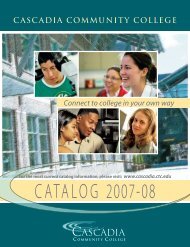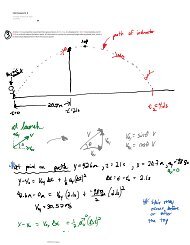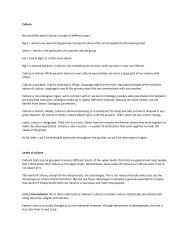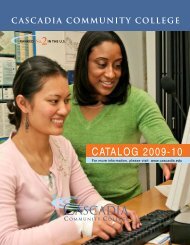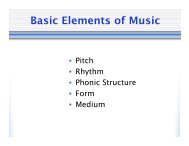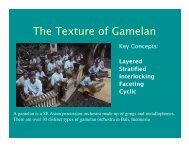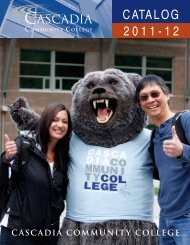CATALOG 2010-11 - Cascadia Community College
CATALOG 2010-11 - Cascadia Community College
CATALOG 2010-11 - Cascadia Community College
- No tags were found...
You also want an ePaper? Increase the reach of your titles
YUMPU automatically turns print PDFs into web optimized ePapers that Google loves.
TUITION, FEES, AND FINANCIAL AIDTUITION, FEES, AND FINANCIAL AIDFinancial Aid RefundPolicyA fair and equitable refund policy isapplied to all financial aid students at<strong>Cascadia</strong> <strong>Community</strong> <strong>College</strong>. Studentswho withdraw, drop classes, or completezero credits for the period of enrollmentfor which they have been charged tuitionand received financial aid may have torepay a portion of the grants and/or loansthey received, as well as any tuition<strong>Cascadia</strong> returns to financial aid programsas a result of withdrawal. This policy doesnot apply to Work-Study earningsreceived. Students who remain enrolledthrough at least 60% of the paymentperiod are considered to have earned 100%of the aid received and will not owe arepayment of financial aid. If a studentcompletes at least one course they will besubject to the Satisfactory AcademicProgress Policy, rather than theRepayment/Return of Funds Policy. Pleasenote that the Financial Aid Repayment/Return of Funds Policy and <strong>Cascadia</strong>’stuition refund policy are separate.Funds are to be returned in the followingorder:1. Unsubsidized Stafford Loan2. Subsidized Stafford Loan3. PLUS (Parent loan)4. Pell Grant5. Academic Competitiveness Grant (ACG)6. Federal Supplemental EducationalOpportunity Grant (SEOG)Students receiving the Washington StateNeed Grant (WSNG) are subject to thestudent Washington State Need GrantRepayment Policy, as defined by theWashington State Higher EducationCoordinating Board. Students who receiveonly a <strong>Cascadia</strong> <strong>Community</strong> <strong>College</strong>Grant without any other federal or statefunding will have the repayment andreturn of funds calculated according tothe calculation described above. Pleasecontact Student Financial Services for acopy of the entire Repayment/Return ofFunds Policy or for more details regardingfinancial aid refunds. You may also viewthe policy via the <strong>Cascadia</strong> website.RightsAll financial aid recipients have the rightto inspect their financial aid files for theaccuracy of the information containedtherein, and to submit corrections.Confidential information covered underthe Privacy Act may not be reviewed byanyone else without prior written approvalof the individual concerned. Requests toreview files should be done in writing andsubmitted to the financial aid office.ResponsibilitiesThe student is responsible for reading andsigning the “conditions of award” on the<strong>Cascadia</strong> Data Sheet, for notifying theStudent Financial Services Office uponreceipt of additional outside income,resources from scholarships and privateloans, and for submitting additionaldocuments as required during the year tothe Student Financial Services Office. Allinformation submitted to the StudentFinancial Services Office must be trueand complete to the best of the student’sknowledge.Tax Credit InformationPlease note: The following is general informationand individuals will be affecteddifferently based on their circumstances. Individualsshould contact their tax advisor orIRS for assistance in claiming the tax credit.Students must provide their social securitynumber to Enrollment Services in order toreceive a 1098T form.The American Opportunity Credit(previously the HOPE tax credit) providesup to $2,500 per student on qualifiedtuition and related expenses for the firsttwo years of post-secondary education.The Lifetime Learning Credit applies toall courses taken to acquire or improvejob skills, whether as part-time, full-time,undergraduate, graduate, or continuingeducation student. There is no limit onthe number of years that the credit isavailable to a student. This credit letstaxpayers claim a maximum credit of$2,000 per taxpayer (20 percent of up to$10,000 paid in higher educationexpenses). It is available to parents ofdependent students or to students whoare not claimed as dependents on theirparents’ federal tax return. Taxpayerscannot take both the AmericanOpportunity Credit and the LifetimeLearning Credit in the same year for thesame student.At the end of the tax year students willreceive a 1098T form from the collegethat will list out-of-pocket expenses fortuition. The 1098T is for notification only;it cannot be sent in with taxes. To claimthe tax credit, students must completeIRS form 8863.Students must be enrolled at least halftimein a degree or certificate program toqualify for the American OpportunityCredit tax credit. The Lifetime Learningtax credit does not require half-timeenrollment.Qualified Tuition andRelated ExpensesThe terms “qualified tuition” and “relatedexpenses” mean the tuition and fees thatan individual is required to pay to beenrolled at an eligible institution forcourses leading to a degree or certificate.Charges and fees related to coursesinvolving sports, games, or hobbies arenot eligible for the credit unless the courseis part of the degree or certificateprogram. Charges and fees associatedwith room, board, student activities,athletics, insurance, books, equipment,transportation, and personal livingexpenses are not qualified. It is up to thestudent to determine which of theirtuition-related expenses are eligible.Four Things to Remember1. Students must provide their socialsecurity number to the Kodiak Cornermain counter when they apply in orderto have a 1098T form mailed to them.2. Obtain a copy of the IRS EducationCredits Tax Form 8863.3. Recalculate the qualified out-of-pockettuition expenses.4. Consult a tax advisor as to whether ornot the credit may be claimed.Learning ResourcesCampus LibraryLibrary CollectionsThe Campus Library provides an array ofprint and electronic resources designed tosupport <strong>Cascadia</strong> students as they pursuetheir educational goals. Books, journals,and multimedia materials are selected bylibrarians and faculty with <strong>Cascadia</strong>’scurriculum in mind. Students also haveaccess to the collections of the Universityof Washington Libraries to furthersupport their studies. The CampusLibrary can be reached at (425) 352-5340.ServicesThe Campus Library features anInformation Commons, which housesover 50 PC workstations that provideinternet access to CD-ROMs, databases,and other web resources, Word, Excel,PowerPoint, and other software. Studentscan do research, write papers, and checkemail all in a single location. Librariansand technology assistants are available inthe Information Commons to assiststudents with research or to providecomputer support. Librarians also teachworkshops and work with faculty to helpstudents develop their abilities to accessand evaluate information.16 Catalog <strong>2010</strong>-<strong>11</strong> <strong>Cascadia</strong> <strong>Community</strong> <strong>College</strong>



